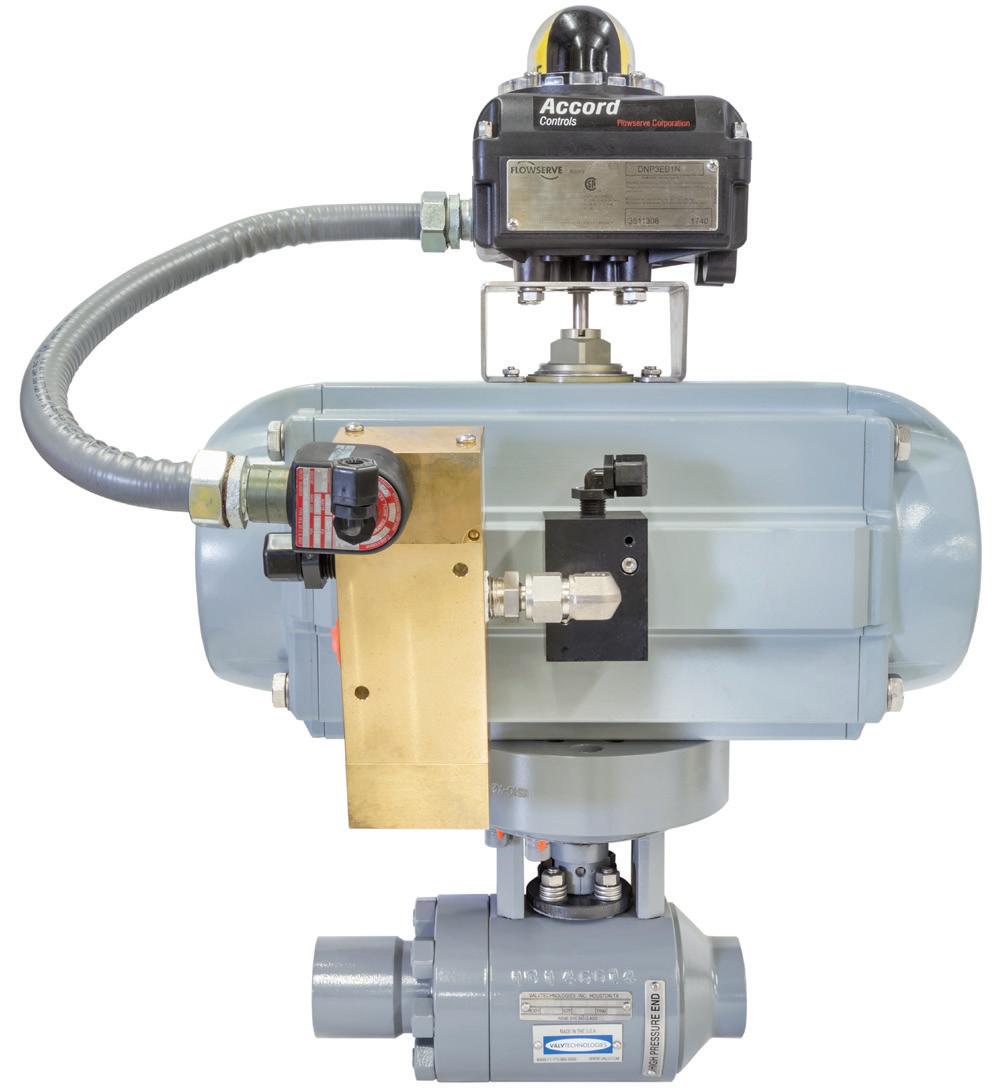
5 minute read
Stepping stones in the energy transition
Richard Laukam, ValvTechnologies; Tim Webb, Severn; and Mark Green, LB Bentley Ltd,
discuss how equipment manufacturers are readying themselves to make a hydrogen-powered future a reality.
As engineers worldwide focus intently on hydrogen, there is an awareness that it is one of the universe’s smallest molecules, and that it diffuses readily through materials as a result – including the base-metal substrates and coatings of the valves that are critical to safe hydrogen processing. A lot of thought is also going into how to filter and dry hydrogen so that it can be transported and stored safely.

Figure 1. Globe valve cryogenic testing.

Figure 2. ValvTechnologies’ 1 in. CL1500 valve with RiTech H coating for pure high-pressure hydrogen.
The safety issues associated with hydrogen have been raised as its potential downfall when used widely. It is therefore important that strong safety measures are taken. However, some of its properties mean that it could in fact be safer than other fuels, such as gasoline and diesel.1
Gaseous hydrogen, when mixed with omnipresent oxygen in the air, can self-ignite (although liquid hydrogen is far less volatile). As such, the hydrogen infrastructure of the future will need to use both isolation and control valves to ensure that hydrogen continues to flow safely.
Zero-leakage isolation valves will be required for the prevention of leaks, both externally and internally – from the valve stem or body/bonnet joints, as well as through the ball and seat. Control valves must operate with precision, preventing external leakage. Filters and dryers, built for longevity, will help to safely transport and store hydrogen.
Fugitive emissions and ‘through’ leakage
Fugitive emissions from quarter-turn valves are governed by the API 641 standard, released in late 2016. As with the earlier standard (API 624 for rising-stem valves), API 641 is the type test for quarter-turn valves, addressing their low-emission performance during an accelerated life cycle.
The new standard applies to all stem-seal materials. To pass API 641, the valve must not allow leakage of more than 100 ppmv for the test’s duration. The standard requires 610 cycles of the valve under extreme, fluctuating temperatures, thereby evaluating emission performance during an accelerated life cycle.
‘Through’ leakage, between the valve’s ball and seat, is addressed by the most stringent ANSI standard: Class VI, for hydrogen service. External leakage, from a body or stem joint leaking to the atmosphere, is addressed by ISO 15848-1. Meeting the standard, at the highest level (AH), typically requires bellows seals or an equivalent stem (shaft) sealing system for quarter-turn valves. ValvTechnologies achieved class AH by using bellows seals rather than fugitive emissions packing.
To process high-purity silicon for a US manufacturer of semiconductors, ValvTechnologies developed its V Series with RiTech® H zero-leakage valves for helium service. The semiconductor manufacturer successfully used nearly 5000 of the zero-leakage valves from 2004 to 2015, when it was compelled to close due to global trade restrictions.
Increasingly, this valve is chosen for select hydrocarbon processes, using either pure or partial hydrogen, at multiple refineries worldwide. In addition to this, it is well suited to the emerging hydrogen market.
Achieving zero-leakage in hydrogen service
To ensure zero hydrogen leakage, these valves (both balls and seats) are coated with a proprietary chemical solution and compressive spray technique that fills and seals the inherent microcracks and porosity of their base metals.
This process is called RiTech, which is short for Robotically Integrated Technology.
Valve components, whether chromium or tungsten carbide, are saturated with the chemical solution at room temperature. They are then fired, chemically bonding the coating and substrate. The firing takes place in a robotically-integrated, high-velocity, oxygen-fuelled spray booth. This process reduces porosity to zero, preventing even the most minor infiltration by hydrogen molecules or corrosives.
The chemical coating is optimum for both impure hydrogen and for pure hydrogen at pressures of less than 3500 psi/241 bar. If pressures exceed this, a spray-and-fuse technique must then be used.
To completely eliminate leakage, an integral seat excludes the possibility of gas escaping between a separate seat and seat pocket. A Belleville spring forces the upstream seat into the ball and, in turn, into the integral seat. The spring load is very high, guaranteeing that hydrogen cannot leak past the seat. With such tight isolation, the valves produce higher operating torques.
Control valve considerations for hydrogen service
Isolation and control valves play different roles: control valves regulate fluid flow by adjusting their flow area, as signalled by a controller, to manipulate pressure, temperature and liquid level. Globe control valves with rising stems use live-loaded, high-integrity gland packing, or even a bellows seal, to precisely control external leakage. These valves typically meet both international and ASME standards.
When selecting a control valve, it is important to look for multiple trim options that will enable the valve to meet future requirements. As hydrogen demand increases, these valves can be retrofitted for precise control. Figure 3. Hydrogen filter and dryer assembly.


Filtering and drying hydrogen
As with compressed air and other industrial gases, hydrogen must be carefully filtered and dried before it can be safely transported or stored. Although the world’s hydrogen infrastructure is still at the conceptual and FEED stages, the technology to filter and dry hydrogen is well proven.
A special concern is hydrogen’s tendency to embrittle metal. However, the use of high-quality raw materials, such as specialised stainless and carbon steels, eliminates that problem. Custom-designed filter and dryer assemblies are manufactured to meet very specific longevity and safety requirements.
“It is important to work closely with customers to define their requirements and develop custom solutions” said Mark Green, Field Sales Manager at LB Bentley Ltd, and co-author of this article. “Highly-engineered services are far from ‘off the shelf,’ and the hydrogen industry should support those required engineering hours.”
He adds: “Hydrogen technology is developing quickly. Our job is to support our customers by offering them well-thought-out solutions throughout their project’s life cycle. It is the only way to fully support the energy transition. Customer/supplier partnerships are crucial to adequately engineer these tough applications.” High-pressure LB Bentley filter and dryer products are already supplied to UK customers and have been operating reliably for more than 20 years, scrubbing and purifying hydrogen to 750 m3/hr at 250 bar working pressure.
Looking to the future
Isolation and control valves, as well as custom-designed filters and dryers, will play a crucial role in the world’s hydrogen future – safely treating, containing and controlling hydrogen in both liquid and gaseous form.
ValvTechnologies, Severn and LB Bentley will continue to develop and refine their products to meet the most exacting performance and safety standards, both during and after the energy transition.
Reference
1. TAE, C., ‘Hydrogen Safety: Let’s Clear the Air’, NRDC, (14 January 2021), https://www.nrdc.org/experts/christian-tae/ hydrogen-safety-lets-clear-air










